Alligator
An alligator is a crocodilian in the genus Alligator of the family Alligatoridae. There are two extant alligator species: the American alligator (Alligator mississippiensis) and the Chinese alligator (Alligator sinensis).
The name alligator is an anglicized form of el lagarto, the Spanish term for "lizard", which early Spanish explorers and settlers in Florida called the alligator.
Alligators have a variety of successful adaptations to their ecological niche that have allowed these reptiles to remain almost unchanged for 200 million years.
A large adult American alligator's weight and length is 800 pounds (360 kg) and 13 feet (4.0 m) long, but can grow to 14.5 feet (4.4 m) long and weigh over 1,000 pounds (450 kg). According to the Everglades National Park website, the largest alligator ever recorded in Florida was 17 feet 5 inches (5.31 m), although according to the Florida Fish and Wildlife Conservation Commission web site the Florida state record for length is a 14 feet 5/8 inches (4.28 m) male from Lake Monroe in Seminole County. The largest specimen ever recorded was found in Louisiana and measured 19 feet 2 inches (5.84 m). The Chinese alligator is smaller, rarely exceeding 7 feet (2.1 m) in length. Alligators have an average of 75 teeth.
The average lifespan for an alligator is 50 years.
Scientific name – Alligator Mississippiensis
Size - 13 feet




